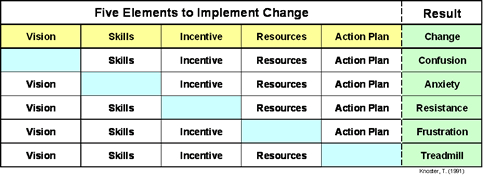You see it all the time. After an initial flurry of excitement and support, an organization’s operational excellence effort bogs down. Regardless of the tools or methodologies used, passion dies down and focus gets diverted to other issues. It doesn’t matter if a company utilizes lean, Six Sigma, theory of constraints, or other tool sets; after a period of time, project velocity decreases and cycle times grow. How can an organization kick-start and reenergize its efforts? This article walks us through this question by looking at fictional company Weaver Industries to see how they pumped new life into their lean Six Sigma effort.
Change management
A critical aspect of any operational excellence philosophy is change management. Change is a scary word for most people, and it seems like the stars have to align in order for change to happen. In effect, the stars do have to align; at least all of the elements of change must be present. Figure 1 shows the elements of change, and the consequences of not having all elements in place.

Figure 1. Elements needed for change to occur
…
Add new comment